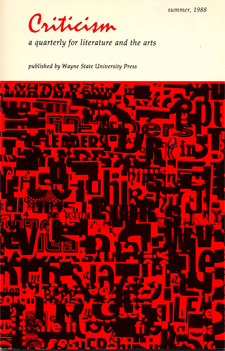Volume 30, Issue 3 (1988) Modern Poetry and the Visual Arts
Introduction
This special issue of Criticism brings together five essays on poetry and the visual arts from early to mid-twentieth-century France and America, reflecting the current high level of theoretical and practical interest in the relations between poetry and painting. Since Jean Hagstrum's classic study, The Sister Arts: The Tradition of Literary Pictorialism and English Poetry from Dryden to Gray (1958) brought interarts comparisons into scholarly focus, a large and prestigious body of work has explored the territory forbidden by Lessing's Laocoon (1766). In addition to many books by literary and art scholars, and a plethora of special issues of journals such as Critical Inquiry, NLH, Mosaic and-most recently-Poetics Today and Style, the elegant new journal (since 1984) Word & Image has brought subtle and ambitious critical attention to bear on a field that comes increasingly to seem not just perverse or exceptional, as Lessing characterized it, but central to the concerns of many important poets and artists. In the spring of 1987, the First International Conference on Word and Image was held in Amsterdam and Utrecht. About two-hundred scholars attended; an association "for Word and Image Studies" was formed; and a second conference was planned for Zurich in 1990.
The five essays in this issue of Criticism, focussing on three high modernist poets and one post-modernist-two French, two American -interrogate a narrow but rich arena of interarts influences and problems. Rosanna Warren begins her essay on Apollinaire with homage to the great "father" of the modernist struggle to overcome the limits of genre, Mallarme; his "Un coup de des" is the ever-unfolding model and guidebook for modern poets' explorations of poetry's relations among the semantic, visual, and aural realms. Apollinaire's response to Oelaunay's cubist experiments with space/place in a poem, "Les Fenetres," whose sense and sound make a cubist simulacrum in words, and his patterned poems, the "Calligrammes," in which words are spatially arranged to "imitate" their statements but nevertheless retain vestiges of traditional poetic meters, delineate a "place" of poetic experimentation to be prospected by his successors in both France and America. At the other end of our time-line, Renee Hubert probes artists' responses to poems of Francis Ponge which use "natural" imagery as a point of departure for reflections in sound and space of the artistic process. As three artists produce visual complementarities to Ponge poems-two after the fact, one in a collaboration- the self-conscious ironies and probings of the poems accrue additional and clarified meanings.
Read more...Preface
Introduction
Suzanne C. Ferguson
Articles
Orpheus the Painter: Apollinaire and Robert Delaunay
Rosanna Warren
Contours of Desire: The Place of Cézanne in Wallace Stevens' Poetics and Late Practice
Betty Buchsbaum
Francis Ponge and Postmodern Illustration
Renée Riese Hubert
Book Review
Book Reviews
Criticism Editors

